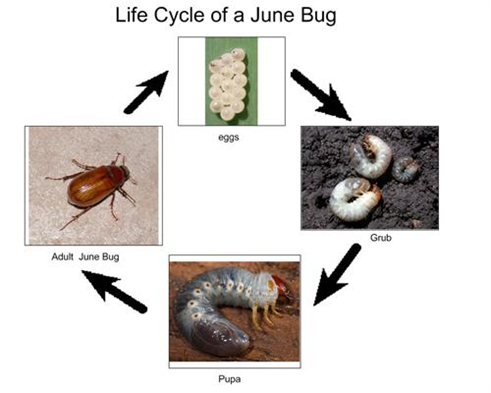If you’ve ever been out on a summer evening outdoors only to be startled by an inch-long, slow-flying beetle crashing into you, then you’ve encountered a June bug (which is actually a beetle) of which I have been receiving many questions.
Adults which are hard to control so we need to control the grubs before they emerge into adults.
As adults, they feast on the leaves of trees and shrubs—roses are a particular favorite—leaving ragged holes in foliage but damage is not extensive. But their larval form, called a grub, does the most damage. White grubs live in soil and feed off the roots of plants, especially grass. The result is large brown patches of dead lawn that easily separate from the soil in chunks or mats of turf. You’ll typically see the damage during the late summer when the grubs are most active underground and it becomes drier. To ensure that June bugs are the culprit, simply lift up a section of dead grass: If you see the slightly curled white grubs in the soil underneath, you know who to blame!
To kill the larva which can cause a lot of damage, don’t mow too low: Female June bugs like to lay their eggs in short grass, so you can discourage them by not mowing your lawn too short. Keep the grass at least three inches tall during their early-to-mid-summer active season.

Apply insecticide, apply these late in the summer, when the grubs are still close to the surface of the soil. Once winter arrives, the grubs will burrow deep underground, where a pesticide is unlikely to affect them.
There are many granular products you can spread on your lawn with a fertilizer spreader starting in July went the larva begins hatching from the eggs.
